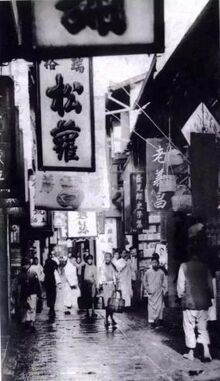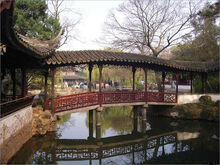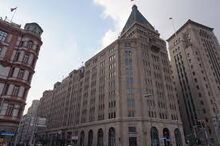Suceng (蘇城) is the second largest city in Nanhan as well as the largest city in Su Province. It is near the centre of the country with many big and prosperous cities such as Wulin and Fanzhou. It was nicknamed heaven on earth to the people from the past due to the cities extreme beauty. Suceng became the capital city of Nanhan after the grand Dragon and Phoenix Palace had been completed. It now sits in the centre of the city.
Suceng is a combination of old and new. To the west of the city is the much more modern Zhubei district where the Gate of Jindou sits. Suceng is famous for the Suceng Gardens which were all world heritage.
Etymology[]
The name for Suceng consists of two letters, 蘇(su) ,which is the province where it is at and 城(ceng) meaning city.
History[]
Suceng had changed name many times, the first name is Zizhou before Lin Dynasty. It was originally a small fishing village until Yongji, one of the 4 emperors arrived to set up a base here that the village became a small town before becoming a city in early Lin Dynasty.
Capital of Jindou[]
In 638 BC, the imperial palace in Hanglin was burnt down. Since Hanglin was far too north, King Ru of Fang to move the capital south to Suceng. As Suceng was not designated as the capital, King Ru assigned his most loyal general, Fu Zixu to oversee the construction of Suceng. The city had a new city wall, two moats, one in the city and another outside. The construction of a new palace in the center of the city with another layer of moat and city wall. Not only that, canals are also constructed in the city in order to transport goods faster. Together with the mash terrain of the surrounding, Suceng becomes an almost impenetrable fortress.
Not just in defense, it was also proven to be formidable against natural disaster. In 623 BCE when the city was finally constructed, a major flood occured. The mayor of the city was Fu Zixu due to his effort in the construction. He decided to open up several water gates next to the main gates of the city. The water dissipated in the canals.
Since then, Suceng had been the center of finance, commerce and governence in all of Jindou. This lasted until today where Suceng remain as the capital city.
During the An Dynasty, the city was faced with many rebellions from the inside against the ruling elites. These were funded by formerly wealth business owners who have been forcefully evicted from their homes in the city. Many of them joined in the Blue Turban Rebellion of 1690. The rebel forces used cannons on the city wall badly damaging it. After the rebels were defeated in 1701, the city was rebuilt and many of the gardens they seized were returned to their former owners.
Colonial Suceng[]

Suceng became the capital city of Cynedrycan Jindou. This brought Cynedrycan architecture to Suceng and Jindou. The first bus system was created in 1826 and tram in 1912. Jindou just like other colonies of Cynedryca exercised relative self-governance and became a prosperous colony for the Cynedrycans.
Independence[]
Following the events of the Cynedrycan Civil War, Jindou fully became autonomous. In 1919, the colonial government lead by Dalvin Elvisarson declared the creation of the Konungur Republic once again with Suceng as the capital city. After the later Jindou Warlord era, Suceng was made the capital of the independent nation of Jindou. Many of Suceng's gardens were devastated by the wars but most were restored by the 1950s.
Geography[]
Climate[]
| Jan | Feb | Mar | Apr | May | Jun | Jul | Aug | Sep | Oct | Nov | Dec | |
|---|---|---|---|---|---|---|---|---|---|---|---|---|
| Highest | 23.4 | 24.3 | 27.3 | 29.2 | 30.1 | 31.1 | 32.1 | 31.2 | 29.3 | 26.3 | 25.8 | 24.2 |
| Average high | 9.7 | 12.3 | 16.3 | 19.9 | 22.2 | 26.1 | 29.1 | 28.8 | 25.3 | 17.2 | 11.3 | 10.2 |
| Average | 4.6 | 6.3 | 9.6 | 12.2 | 19.3 | 25.2 | 27.3 | 26.5 | 25.2 | 16.5 | 9.2 | 6.2 |
| Average low | 3.2 | 5.6 | 6.4 | 8.5 | 10.1 | 12.4 | 18.3 | 17.2 | 16.2 | 15.2 | 7.2 | 4.3 |
| Lowest | -7.3 | -3.2 | 2.3 | 6.4 | 9.3 | 11.2 | 16.2 | 16.1 | 15.5 | 14.9 | 6.3 | -0.3 |
Politics[]
Structure[]
| Title | Mayor |
|---|---|
| Name | Gao Ziyang |
| Ancestral Home | Suceng, Su Province |
| Age | 60 |
| Assumed office | January 2003 |
Administrative Districts[]
| Name | Postal Code |
|---|---|
| Yin'an | 100000 |
| Taolin | 110000 |
| Zhubei | 120000 |
| Sucang | 130000 |
| Yangjun | 140000 |
| Meijun | 150000 |
| Jin'an | 160000 |
Transportation[]
Public Transportations[]
Suceng has many ways of transporting people, trams, buses, taxi and the metro. All public transportations in Nanhan could use the All Suceng Transport Card.
The Suceng Bus Company is the only bus company in Jindou. Beginning in 1826, the bus system is one of the oldest in the world. Suceng's buses are also known to be one of the most renewable in the world. 70% of the buses in Jindou uses biofuel or other renewable energy.

The mass transit system in Suceng is also the largest in Nanhan. The Suceng Metro had 15 lines in Suceng as of December 2019. It works 24 hours a day 7 days a week transporting up to 4 million passengers per day.
The tram system in Suceng was created in 1912 called the Suceng Tram. It was the second in Jindou, the first being Kana. It was used in almost every part of the city but its demand became much lesser with the introduction of metros and buses. Now, it is only limited to the city centre.

Air and Sea[]
Suceng Meijun International Airport and Suceng Jin'an International Airport are the two airports that serve Suceng. The largest one being Suceng Meijun International Airport with 4 terminals. Suceng Meijun International Airport is also home to the Jin Air, the state-owned airline company.

Roads and expressways[]
Suceng has a sophisticated expressway linking the city with other surrounding cities. It has many bridges linking to the other side of the Jin River the oldest is the Zhukou Jin River Bridge built in 1936. Most roads in the city have bicycle lanes to encourage riding bicycles to work or anywhere in the city.
Railways[]
Suceng being located at the heart of Nanhan has been a hub for railways since it's establishment in 1834 by Cynedryca. The first high-speed train was tested here before it's opening in 2001 with the Hanglin-Suceng HSR now many lines are open connecting other cities with Jindou.
Cityscapes[]
Landmarks[]

Ministry of Culture and Tourism

Gate of Jindou
Gates of Suceng[]
See Gates of Suceng
Architecture[]

South Palace Garden located south of the Dragon and Phoenix Palace
Suceng has a variety of architectural style from the more traditional houses in Yin'an and Taolin to the western architecture of Sucang to the more modern architecture of Jin'an and Zhubei. Suceng is most famous for their gardens. The largest of which would be the South Palace Garden which is located south of the Dragon and Phoenix Palace. Many traditional gardens are located near the palace which is located at Yin'an District. Many canals also flows through the city giving it the nickname "Frösthafen of the East" The most famous of which was the Yin'an River which flows through the Yin'an District. Along the river, you will find the famous Zhita Street which will lead you to the Bao'en Temple where the Bao'en tower sits. The traditional architecture were also used on modZhita Streeern buildings like the Ministry of Culture and Tourism.

Unity Hotel a symbol of Colonial rule
Sucang is the administrative region of Suceng during the Colonial Era. The Cynedrycan Congress of Jindou (Now the Jindou National History Museum) was where the Governor worked. The Unity Hotel was also built during the colonial years. Sucang was where the colonial elites live. The district was not allowed by any locals unless they are rich and wealth until the end of the war of independence. The buildings were luxurious. The Ganlin Palace which was built in western architecture served as the living quaters of the Governor lived.

Jianghe Tower
The more modern part, Zhubei is located east of the city facing the Zhulan Lake and the Gate of Jindou is located. Facing the Jin River is the Jin'an District next to Sucang the Jianghe Tower is the tallest building in Jindou with 101 storeys. The city has one of the most numbers of skyscrapers in the world.

